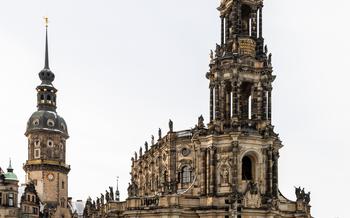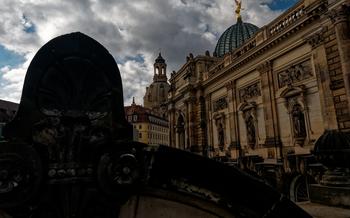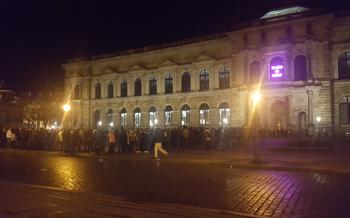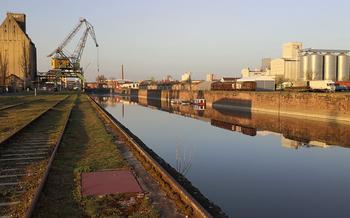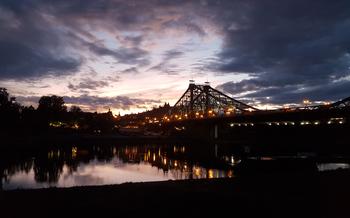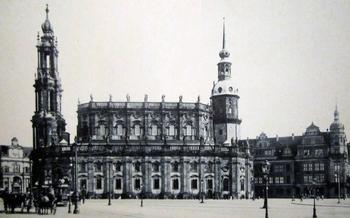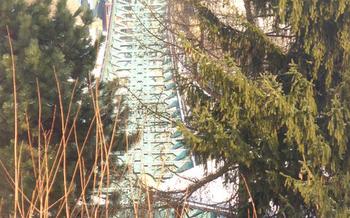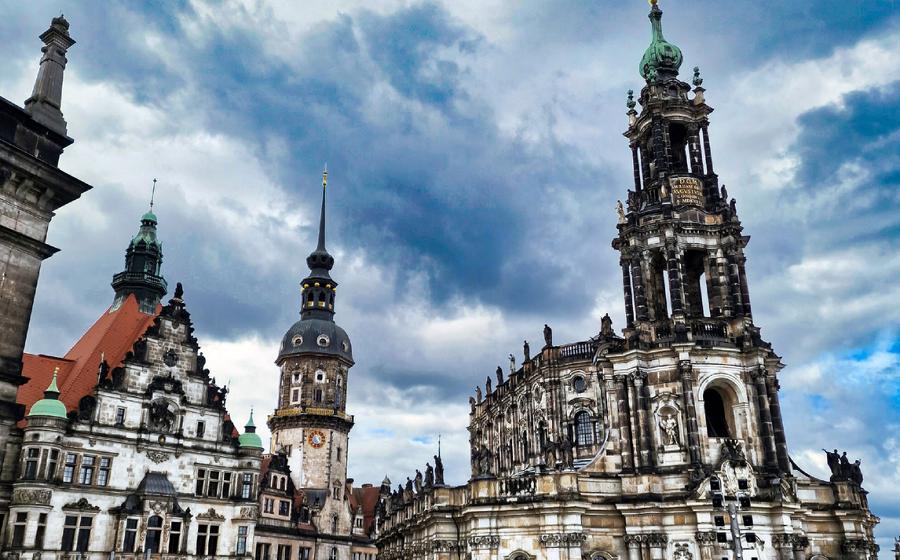
Schlossplatz
- The Royal Palace (Residenzschloss):
- The Zwinger Palace:
- The Semper Opera House: Architectural Marvel and History
- The Church of Our Lady (Frauenkirche):
- The Procession of Princes (Fürstenzug):
- The Albertinum Museum:
- The Brühl's Terrace (Brühlsche Terrasse):
- The Augustus Bridge (Augustusbrücke):
- The Dresden Transport Museum
- The Dresden Panometer
- The Neustadt District: Vibrant Bohemia Across the River
- Historical Elegance and Cultural Landmarks
- Trendy Cafes, Restaurants, and Bars
- Exploring the Kunsthofpassage Art Courtyards
- Insider Tip: Take a Neustadt Walking Tour
- The Elbe River and River Cruises
- Insider Tip: Unveiling Dresden's Hidden Gems
The Royal Palace (Residenzschloss):
The Residenzschloss, or Royal Palace, stands as a testament to Dresden's regal past. Its history is a tapestry of architectural evolution, weaving together diverse styles from the Renaissance to the Baroque. Initially conceived as a fortress in the 13th century, the palace underwent several transformations, reflecting the changing tastes and aspirations of its royal occupants.
In the 16th century, the palace embraced the Renaissance aesthetic, showcasing intricate carvings and delicate ornamentation. However, it was during the Baroque era that the Residenzschloss truly blossomed. Under the patronage of Augustus the Strong, the palace underwent a grand expansion, resulting in the opulent Baroque masterpiece we see today.
The palace's interior is a treasure trove of artistic wonders. The Hall of Mirrors, with its shimmering chandeliers and resplendent ceiling frescoes, reflects the grandeur of the court. The Giant's Hall, with its colossal sculptures and allegorical paintings, evokes a sense of awe and majesty.
Today, the Residenzschloss houses several museums, including the Dresden State Art Collections, the Numismatic Cabinet, and the State Museum of Prehistory. These collections offer a glimpse into the rich cultural heritage of Saxony, showcasing masterpieces from antiquity to the present day.
Guided tours of the Residenzschloss provide an immersive experience, allowing visitors to unravel the palace's fascinating history and admire its architectural splendor. The palace's accessibility, with ramps and elevators, ensures that everyone can explore this architectural gem.
The Zwinger Palace:
The Zwinger Palace, a magnificent Baroque masterpiece, stands as a testament to Dresden's architectural prowess. Its construction began in 1710 under Augustus the Strong, the Elector of Saxony and King of Poland, who envisioned a grand space for court festivities and artistic pursuits.
Architecturally, the Zwinger is a harmonious blend of sandstone and wrought iron, adorned with intricate carvings and sculptures. Its four corner pavilions, connected by elegant galleries, enclose a series of courtyards, each with its own distinct character. The Kronentor, or Crown Gate, serves as the palace's grand entrance, featuring an impressive sculptural ensemble representing the Polish-Saxon union.
Inside the Zwinger, visitors can explore several world-renowned museums and art collections. The Gemäldegalerie Alte Meister, or Old Masters Picture Gallery, houses a treasure trove of paintings from the 15th to the 18th centuries, including works by Raphael, Titian, and Rembrandt. The Porzellansammlung, or Porcelain Collection, showcases exquisite porcelain masterpieces from Meissen and other renowned European manufactories.
The Zwinger is also a vibrant cultural hub, hosting concerts, exhibitions, and other events throughout the year. The Zwinger Summer Concerts, held in the picturesque courtyard, offer a delightful blend of classical music and Baroque ambiance. The palace also hosts temporary exhibitions, showcasing contemporary art and historical artifacts from around the world.
The Semper Opera House: Architectural Marvel and History
The Semper Opera House, a symbol of Dresden's cultural heritage, stands as an architectural masterpiece that has captivated audiences for over 150 years. Its rich history dates back to 1841 when Gottfried Semper, a renowned architect, designed the original building. The opera house quickly became a center for the performing arts, hosting world-renowned operas, ballets, and concerts.
Tragically, the original Semper Opera House fell victim to a devastating fire in 1869, reducing it to ashes. However, the city's unwavering commitment to the arts led to its reconstruction, and in 1878, the new Semper Opera House, designed by Semper's son, Manfred, opened its doors once again.
The reconstructed opera house showcased a fusion of architectural styles, blending Renaissance and Baroque elements with a touch of neoclassicism. Its opulent façade, adorned with intricate sculptures and allegorical figures, hints at the grandeur that awaits within.
The Church of Our Lady (Frauenkirche):
The Church of Our Lady, or Frauenkirche, stands as a testament to resilience and reconstruction. This iconic Lutheran church, with its distinctive dome, has witnessed centuries of history and undergone a remarkable journey. Originally built in the 18th century, the church became a symbol of Dresden's architectural prowess. However, during World War II, it suffered extensive damage and was reduced to ruins.
The reconstruction of the Frauenkirche was a monumental undertaking that spanned decades. With meticulous care and attention to detail, the church was painstakingly rebuilt, using original plans and techniques. The result is a stunning replica that captures the essence of the original masterpiece.
The interior of the Frauenkirche is equally impressive, featuring a spacious nave, elegant galleries, and intricate carvings. The acoustics within the church are renowned, making it a sought-after venue for concerts and choral performances. Visitors can admire the church's grand organ, which boasts over 3000 pipes and fills the space with its majestic sound.
Guided tours of the Frauenkirche provide insights into its history, architecture, and reconstruction. Regular worship services are also held, allowing visitors to experience the spiritual atmosphere of this sacred space. Whether seeking a moment of contemplation or marveling at its architectural grandeur, the Frauenkirche remains a must-visit attraction in Dresden.
The Procession of Princes (Fürstenzug):
A unique artistic masterpiece adorns the outer wall of the Stallhof, a courtyard within the Dresden Castle complex. The Procession of Princes, or Fürstenzug in German, is a remarkable ceramic mural that depicts a parade of Saxon rulers from the Wettin dynasty. Spanning over 100 meters in length, this grand artwork tells a visual story of Saxony's rich history and heritage.
Created in the late 19th century, the Fürstenzug features over 35,000 Meissen porcelain tiles, hand-painted with meticulous detail. Each tile portrays a different ruler, from the dynasty's founder, Henry the Fowler, to Frederick Augustus III, the last king of Saxony. The procession is arranged chronologically, allowing viewers to trace the lineage of the Wettin dynasty and witness the evolution of their attire and regalia over time.
The künstlerzug is not only visually stunning but also holds great symbolic significance. It represents the unity and continuity of the Saxon monarchy and serves as a reminder of the dynasty's enduring legacy. The mural has survived wars, political upheavals, and the passage of time, standing as a testament to Dresden's resilience and its enduring cultural heritage.
To fully appreciate the Fürstenzug, it's best to view it from a distance, allowing the intricate details and the overall composition to come into focus. The mural is accessible to the public and can be viewed from both the Schlossplatz and the Stallhof. Guided tours are available, providing insights into the history, symbolism, and artistic techniques employed in its creation.
The Albertinum Museum:
A haven for art enthusiasts, the Albertinum Museum showcases a remarkable collection spanning various eras. Step into the Old Masters Gallery and marvel at masterpieces by Raphael, Giorgione, and Rembrandt. Gaze upon the exquisite collection of sculptures, ranging from classical to modern works, that adorn the museum's halls. Don't miss the temporary exhibitions that bring contemporary art and thought-provoking installations to life. Immerse yourself in the vibrant world of art as you explore the Albertinum's diverse offerings, sure to captivate and inspire your artistic sensibilities.
The Brühl's Terrace (Brühlsche Terrasse):
Amidst the architectural wonders of Dresden's city center, the Brühl's Terrace (Brühlsche Terrasse) stands out as a picturesque riverfront promenade. This enchanting stretch along the Elbe River offers breathtaking panoramic views, making it a beloved spot for locals and visitors alike.
As you stroll along the terrace, the beauty of the Elbe River unfolds before you, with its shimmering waters reflecting the grandeur of the city's skyline. The terrace's balustrade provides an ideal vantage point to admire the majestic Augustus Bridge, with its elegant arches and intricate sculptures. The surrounding buildings, with their Baroque and Renaissance facades, add to the enchanting ambiance of this riverside haven.
Originally conceived in the 16th century, the Brühl's Terrace underwent several transformations before reaching its present form in the 19th century. It was named after Count Heinrich von Brühl, a prominent statesman who played a significant role in the development of Dresden during the 18th century.
Today, the Brühl's Terrace is not just a scenic promenade but also a vibrant cultural hub. It is home to several museums, including the Albertinum, which houses an impressive collection of Old Masters paintings and sculptures. The terrace also hosts various cultural events throughout the year, including concerts, exhibitions, and festivals.
Among the highlights of the terrace are the numerous restaurants, cafes, and bars that line its promenade. Whether you prefer a leisurely breakfast overlooking the river, a romantic dinner with a view, or a refreshing drink while watching the sunset, the Brühl's Terrace offers a delightful culinary experience.
As you soak in the beauty of the Brühl's Terrace, don't forget to take a moment to appreciate the historical significance of this place. It was here that the people of Dresden gathered to celebrate the city's liberation from Nazi rule in 194The terrace has since become a symbol of hope, resilience, and the indomitable spirit of Dresden.
The Augustus Bridge (Augustusbrücke):
A true testament to Dresden's architectural prowess, the Augustus Bridge (Augustusbrücke) stands as a Baroque masterpiece that gracefully spans the mighty Elbe River. Completed in 1731, this bridge has witnessed centuries of history unfold upon its sturdy foundations. Its elegant design, adorned with intricate sculptures and balustrades, blends seamlessly with the cityscape, creating a picturesque panorama that draws countless visitors.
Strolling along the Augustus Bridge offers a unique perspective of Dresden's iconic landmarks. Admire the grand silhouette of the Frauenkirche, the majestic Zwinger Palace, and the spires of the Hofkirche, all framed against the backdrop of the flowing Elbe. Whether you choose to cross the bridge on foot or by vehicle, the experience is equally captivating.
Take a moment to pause and marvel at the bridge's impressive features. The central arch, spanning over 39 meters, is a testament to the engineering prowess of the era. The intricate sculptures adorning the bridge's balustrades depict various mythological and historical figures, adding a touch of grandeur and artistry to its overall design.
As you stroll across the Augustus Bridge, let the gentle breeze carry you away and soak in the vibrant atmosphere of Dresden. The riverbanks teem with life, with swans gliding gracefully on the water's surface, street musicians filling the air with melodies, and locals and tourists alike enjoying leisurely walks or bike rides.
Crossing the Augustus Bridge is not just a means of transportation; it's an experience that transports you back in time and allows you to appreciate the enduring beauty and grandeur of Dresden's architectural heritage.
The Dresden Transport Museum
A Journey Through Dresden's Transportation History
Discover the fascinating history of transportation in Dresden at the Dresden Transport Museum, located in the historic Johannstadt district. Immerse yourself in a world of vehicles, technology, and infrastructure that shaped the city's development over the centuries.
The museum's collection encompasses a wide range of exhibits, from horse-drawn carriages and vintage automobiles to trams, buses, and even aircraft. Explore the evolution of transportation from its humble beginnings to the modern marvels we rely on today.
Interactive displays and hands-on experiences bring the exhibits to life, making learning a fun and engaging experience. Step into the driver's seat of a historic vehicle, operate a model railway, or test your skills on a virtual driving simulator.
Guided tours are available to provide deeper insights into the museum's collection and the history of transportation in Dresden. Learn about the city's role as a major transportation hub and the innovations that emerged from its workshops and factories.
The Dresden Transport Museum is a must-visit for anyone interested in transportation history, engineering, or simply the unique stories that vehicles can tell. It's a place where the past and the present converge, offering a glimpse into Dresden's rich heritage and its ongoing journey towards a sustainable future.
The Dresden Panometer
Immerse Yourself in Panoramic Masterpieces:
Discover a unique artistic experience at the Dresden Panometer, an innovative exhibition space showcasing breathtaking 360-degree panoramic artworks. Step into a world where history, art, and technology converge, as you're surrounded by captivating visuals that transport you to different eras and locales.
The Panometer offers a variety of exhibitions, each presenting a distinct theme or historical event through meticulously crafted panoramic artworks. From ancient landscapes to iconic battles and modern cityscapes, the subjects are diverse and engaging.
Immerse yourself in the stunning details and vibrant colors as you walk amidst these monumental paintings, feeling as if you've been transported to another time and place. The immersive experience is further enhanced by the cylindrical shape of the building, creating an uninterrupted visual field that envelops you in the artwork.
In addition to the main exhibitions, the Panometer also hosts educational programs, workshops, and guided tours. These offerings provide insights into the creation process, the historical context of the artworks, and the techniques used to achieve the panoramic effect.
Whether you're an art enthusiast, a history buff, or simply looking for a unique and awe-inspiring experience, the Dresden Panometer is a must-visit destination. Prepare to be captivated by the magic of panoramic art as you journey through time and space, all within the confines of this remarkable exhibition space.
The Neustadt District: Vibrant Bohemia Across the River
Nestled on the opposite bank of the Elbe River, the Neustadt district exudes a bohemian charm that contrasts with the grandeur of the Altstadt. This vibrant neighborhood is a hub of creativity, culture, and nightlife, attracting locals and visitors alike.
Historical Elegance and Cultural Landmarks
Stroll along the cobbled streets of Neustadt and admire the architectural diversity, from Baroque townhouses to Art Nouveau facades. Discover hidden courtyards adorned with murals and sculptures, each telling a unique story. Explore historic landmarks like the Golden Rider statue, the Pfund's Molkerei dairy shop, and the Kunsthofpassage, a complex of interconnected courtyards showcasing contemporary art installations.
Trendy Cafes, Restaurants, and Bars
Neustadt's culinary scene is as diverse as its architecture. Indulge in delectable local cuisine at traditional German restaurants, savor international flavors at trendy bistros, or sip craft beers at cozy pubs. The district is also home to a thriving nightlife, with lively bars, music venues, and clubs catering to every taste.
Exploring the Kunsthofpassage Art Courtyards
A must-visit in Neustadt is the Kunsthofpassage, a hidden gem that showcases the district's artistic spirit. This complex of interconnected courtyards is adorned with vibrant murals, sculptures, and installations created by local and international artists. Each courtyard has a unique theme, from the "Hof der Elemente" (Courtyard of the Elements) to the "Hof der Metamorphosen" (Courtyard of Metamorphoses).
Insider Tip: Take a Neustadt Walking Tour
To fully immerse yourself in Neustadt's bohemian atmosphere, join a guided walking tour. Local guides will take you through the district's hidden alleys, share fascinating stories, and introduce you to its vibrant art scene. Discover the Neustadt district, an eclectic blend of history, culture, and contemporary urban life, offering a unique perspective on Dresden's diverse character.
The Elbe River and River Cruises
The Elbe River is an integral part of Dresden's charm and offers a unique perspective on the city's beauty. Embark on a scenic boat trip or river tour to witness the city's landmarks from a different angle. Glide past the magnificent Semper Opera House, the Frauenkirche, and the Brühl's Terrace, admiring their grandeur from the water.
The river cruises offer a relaxing and informative way to explore Dresden. Choose from various routes and durations, depending on your interests and time constraints. Some cruises provide dining options, allowing you to savor a delicious meal while enjoying the stunning views.
Venturing beyond the city center, the Elbe River offers enchanting landscapes and natural wonders. Explore the Elbe Valley with its picturesque villages, rolling hills, and lush forests. Discover hidden gems such as the Saxon Switzerland National Park or the Moritzburg Castle, known for its stunning Baroque architecture and idyllic lake setting.
Whether you prefer a leisurely sightseeing cruise or an adventurous exploration of the surrounding region, the Elbe River promises an unforgettable experience. Let the gentle currents guide you through history, nature, and the captivating charm of Dresden.
Insider Tip: Unveiling Dresden's Hidden Gems
Beyond the renowned landmarks, Dresden offers a treasure trove of hidden gems waiting to be discovered. Venture off the beaten path and uncover the city's lesser-known attractions. Explore the Kunsthofpassage, a series of enchanting art courtyards nestled in the heart of the Neustadt district. Each courtyard is adorned with unique murals, sculptures, and installations, creating a vibrant and artistic atmosphere.
For a culinary adventure, seek out the Pfund's Molkerei, a traditional dairy shop that has been serving delicious ice cream and pastries since 1880. Indulge in their signature Eiskaffee, a refreshing blend of coffee and ice cream, while soaking up the nostalgic ambiance of the shop.
To experience the city's thriving contemporary art scene, visit the Kunsthaus Dresden, a former power plant transformed into a vibrant art space. Explore its rotating exhibitions showcasing works by both established and emerging artists.
For a unique perspective of Dresden, embark on a leisurely stroll along the Elbe Cycle Path. This scenic route offers breathtaking views of the river, the city skyline, and the surrounding countryside. Take a break at one of the many charming cafes or restaurants along the way to savor local delicacies and enjoy the tranquil atmosphere.
Discover the magic of Dresden's hidden gems, whether it's exploring secret courtyards, savoring culinary delights, immersing yourself in contemporary art, or cycling amidst picturesque landscapes. These lesser-known experiences will provide a deeper connection to the city's rich history, culture, and vibrant spirit.
